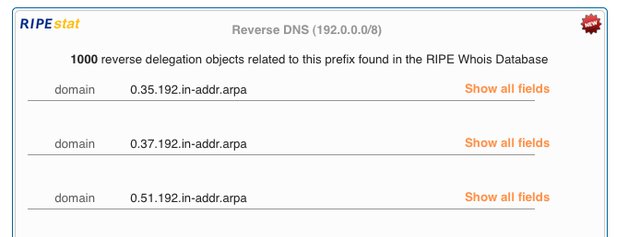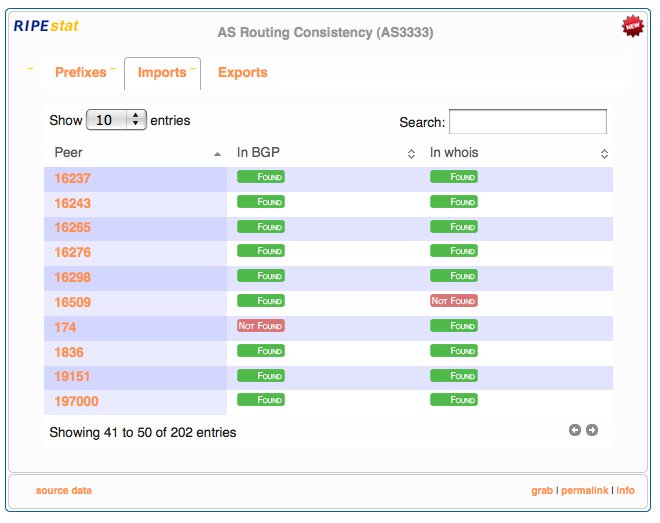In this month's public demo (s2e02), we present two completely new views in RIPEstat: now you can see reverse DNS information for an IP prefix, and the neighbours of your AS number. In the second video this year, RIPEstat developers also explain other work they have done to improve our main interface to all-things-IP: RIPEstat.
Introduction to RIPEstat
RIPEstat is a modular and extendable toolbox designed as a single point of access to Internet-related data from RIPE NCC and other sources. It is a work in progress, and is being developed iteratively. Feedback from users helps determine the direction of development. Regular demos provide information about new functionality.
The video recording of this month's demo session is accessible on YouTube. The demo slides are also available.
Looking-up Reverse DNS
When you search for an IPv4 or IPv6 prefix, you will now get one extra box with the following information: a domain object as registered in the RIPE Database showing the reverse delegation for that address range. The default result only shows the main attributes:
- Prefix-in-reverse.inaddr.arpa
- Name servers responsible for that delegation and
- Description.
Currently it only shows information for address ranges registered in the RIPE Database (not for address space distributed via other Regional Internet Registries). You can get this information as a data API, or as a widget. It is also possible to embed the widgets in your own web-page (if you want to know how to do that, please see RIPEstat Demo - s2e01 ).

Making the reverse DNS data visible in RIPEstat is only a basic functionality. This will be extended in the following months by adding a correlation with new data sources (information from CAIDA about the hosts within this prefix; checking for the "lameness" of nameservers, DNSSEC data), and combining with other views into the composite view (for example, IPv6 RIPEness ).
For more information on how to interpret reverse DNS data, or how to set up your reverse DNS, please see the reverse delegation pages on the RIPE NCC web site.
Finding your AS neighbours (text only)
Following user requests, we created a new module: "AS Neighbours". This is inspired by the "asinuse" tool based on the Routing Information Service (RIS).
This module shows who the peers/neighbours of (your) Autonomous System (AS) number are, as seen in RIS. The time-interval default is "one day ago", but you can also specify other points in time (we have historical information for up to one year available for this lookup).
For now, we only provide the data API. We are working on the graphical visualisation of the same data.
Please see below an example for the usage of this new functionality (for AS3333):
Input:
https://stat.ripe.net/plugin/asn-neighbours/data.json?resource=AS3333
Output:
"data": {
"neighbour_counts": {
"left": 33,
"right": 173,
"unique": 174
"neighbours": [
{
"asn": 41095,
"power": 6,
"type": "left"
}
The number of neighbours tells you how many AS numbers were on the "left side" of the queried AS number in the AS-path (closer to the origin of the announced prefixes), and how many were on the "right side" (if it has only left ones, it's an originating-only ASN). For each one of the neighbours, for example "AS41095" it lists the "type" (left/right) and "power": how many times was it seen in AS-paths.
Improved AS Routing Consistency widget
As we announced in the January demo, we implemented a new module called "AS Routing Consistency". It compares AS number information as seen in the RIPE Routing Registry with the real-time BGP routing information, as collected by RIS. There used to be a service like this, called RRCC, but RIPEstat now provides a graphical view of this information. You can access this information as a widget and as data API.

Prefixes compares routing data gathered by RIS to those route objects in the Routing Registry that have the specified AS as their origin.
Imports compares routing data gathered by RIS to 'import' and 'mp-import' lines in the 'aut-num' object for the specified AS as seen in the Routing Registry.
Exports compares routing data gathered by RIS to 'export' and 'mp-export' lines in the 'aut-num' object for the specified AS as seen in the Routing Registry.
Streamlined "landing page"
We also made some improvements on the front page and implemented some suggestions made by our users. Most prominently on the page is the search box. Information you most often look for, is now made accessible in the space below the search box using icons for:
- Feedback channels
- Data API explained
- Change-log and
- Help.
Also, all previous demo videos were migrated to YouTube, and made more visible on the RIPEstat home page.

Smaller upgrades
We implemented support for unified "RIPE NCC Access" in the backend. For now, as a user, you will not notice anything special, but in the future this will enable us to recognise if you are logged-in for any of the other RIPE NCC authenticated services, and to offer you user-specific functionality. For example, your comments will be signed by your username, the settings of your customised preferences (what widgets to display and in which order) will be preserved beyond your browser session and other advanced personalised features will be available. If you have more ideas, please share them with us.
We also increased the size limit for the prefix queries from a /10 to a whole /8. This enables you to get LOADS of information in just one lookup. After we've tweeted about it, our backend system got thoroughly tested - and survived. But, beware: huge amounts of data can cause problems with your client. If that happens, please let us know, and we'll think together on how can we help you.
We have improved the handling of special resources: IP ranges and AS numbers, for example private addresses as specified in RFC1918, address ranges used for the 6to4 transition mechanism and AS0. We maintain a list of these exceptions as a separate widget on the RIPEstat web pages.
Future focus & feedback
Please let us know what you want us to work on first. Our plans include the following:
- Visual RIPE database objects representation
- Adding historical view to GeoIP data
- Improving the "noise/junk filtering" for the routed prefix history view and
- Extensions of the reverse DNS functionality.
There are some concrete questions we have for you:
- Have you embedded one of our widgets on your web page? Which one? How is it performing? Please let us know. We would like to collect "success user stories".
- Which one of the new reverse DNS features would you like the most:
a) hosts
b) lameness
c) IPv6 RIPEness
d) DNSSEC
3. Do you have feedback about our "special resources" list?
Please let us know what you think, either by leaving a comment under this article, or via one of the following channels:
- The comment box on the RIPEstat website allows you to post comments publicly.
- The Measurement Analysis and Tools (MAT) working group mailing list allows for more in-depth discussions.
- Private feedback can be sent to stat@ripe.net .
- The #ripestat tag on Twitter is used by RIPE NCC to discuss and announce RIPEstat.
Future Demo
The next RIPEstat demo is scheduled for release on Tuesday, 20 March 2012. It will be accompanied by an article on RIPE Labs.
Video Archive
Videos of previous RIPEstat demos and other RIPEstat movies are available on the RIPE NCC YouTube channel (look for the RIPEstat playlist).





Comments 0
The comments section is closed for articles published more than a year ago. If you'd like to inform us of any issues, please contact us.